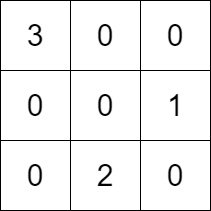Description
You are given a positive integer k. You are also given:
- a 2D integer array
rowConditionsof sizenwhererowConditions[i] = [abovei, belowi], and - a 2D integer array
colConditionsof sizemwherecolConditions[i] = [lefti, righti].
The two arrays contain integers from 1 to k.
You have to build a k x k matrix that contains each of the numbers from 1 to k exactly once. The remaining cells should have the value 0.
The matrix should also satisfy the following conditions:
- The number
aboveishould appear in a row that is strictly above the row at which the numberbelowiappears for allifrom0ton - 1. - The number
leftishould appear in a column that is strictly left of the column at which the numberrightiappears for allifrom0tom - 1.
Return any matrix that satisfies the conditions. If no answer exists, return an empty matrix.
Example 1:

Input: k = 3, rowConditions = [[1,2],[3,2]], colConditions = [[2,1],[3,2]] Output: [[3,0,0],[0,0,1],[0,2,0]] Explanation: The diagram above shows a valid example of a matrix that satisfies all the conditions. The row conditions are the following: - Number 1 is in row 1, and number 2 is in row 2, so 1 is above 2 in the matrix. - Number 3 is in row 0, and number 2 is in row 2, so 3 is above 2 in the matrix. The column conditions are the following: - Number 2 is in column 1, and number 1 is in column 2, so 2 is left of 1 in the matrix. - Number 3 is in column 0, and number 2 is in column 1, so 3 is left of 2 in the matrix. Note that there may be multiple correct answers.
Example 2:
Input: k = 3, rowConditions = [[1,2],[2,3],[3,1],[2,3]], colConditions = [[2,1]] Output: [] Explanation: From the first two conditions, 3 has to be below 1 but the third conditions needs 3 to be above 1 to be satisfied. No matrix can satisfy all the conditions, so we return the empty matrix.
Constraints:
2 <= k <= 4001 <= rowConditions.length, colConditions.length <= 104rowConditions[i].length == colConditions[i].length == 21 <= abovei, belowi, lefti, righti <= kabovei != belowilefti != righti
Solution
C++
class Solution {
public:
// With Kahn's algorithm
vector<int> topoSort(vector<vector<int>>& A, int k) {
vector<int> indegree(k);
vector<vector<int>> graph(k);
queue<int> q;
for (auto& condition : A) {
int u = condition[0] - 1, v = condition[1] - 1;
graph[u].push_back(v);
indegree[v]++;
}
for (int i = 0; i < k; i++) {
if (indegree[i] == 0) q.push(i);
}
vector<int> order;
while (!q.empty()) {
int node = q.front(); q.pop();
order.push_back(node);
for (int adj: graph[node]) {
indegree[adj]--;
if (indegree[adj] == 0) {
q.push(adj);
}
}
}
if (order.size() != k) return vector<int>();
return order;
}
vector<vector<int>> buildMatrix(int k, vector<vector<int>>& rowConditions, vector<vector<int>>& colConditions) {
int rows = rowConditions.size(), cols = colConditions.size();
vector<int> topoRow = topoSort(rowConditions, k), topoCol = topoSort(colConditions, k);
if (topoRow.empty() || topoCol.empty()) return vector<vector<int>>();
vector<vector<int>> ans(k, vector<int>(k));
vector<int> rowMp(k), colMp(k);
for (int i = 0; i < k; i++) {
rowMp[topoRow[i]] = i;
colMp[topoCol[i]] = i;
}
for (int i = 0; i < k; i++) {
ans[rowMp[i]][colMp[i]] = i + 1;
}
return ans;
}
};Python3
class Solution:
def buildMatrix(self, k: int, rowConditions: List[List[int]], colConditions: List[List[int]]) -> List[List[int]]:
res = [[0] * k for _ in range(k)]
def topoSort(A):
adj = [[] for _ in range(k + 1)]
for a, b in A:
adj[a].append(b)
seen = [False] * (k + 1)
order = []
def dfs(x):
if seen[x]: return
seen[x] = True
for nei in adj[x]:
if not seen[nei]:
dfs(nei)
order.append(x)
for x in range(1, k + 1):
dfs(x)
order.reverse()
M = {j: i for i, j in enumerate(order)}
if all(M[i] < M[j] for i, j in A):
return order
return None
R = topoSort(rowConditions)
C = topoSort(colConditions)
if R is None or C is None:
return []
RM = {j : i for i, j in enumerate(R)}
CM = {j : i for i, j in enumerate(C)}
for x in range(1, k + 1):
res[RM[x]][CM[x]] = x
return res